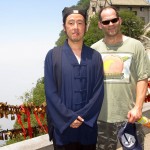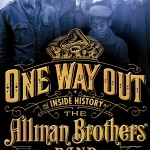Big in China Excerpt: Laoshi Yechen on Fake Monks
I read this WSJ China Real Time with great interest: A fake monk scandal scars one of the country’s sacred mountains.
It got me thinking and prompted me to post this Big in China excerpt about my Chinese teacher turned monk Yechen. He spoke to me endlessly about “fake monks,” both in Beijing and at Huashan, the holy mountain where he moved and I visited him. I think the Yechen storyline was overlooked. I wish more people had picked up on it.
Excerpt from Big in China Chapter 16, Into the Mystic. Copyright 2011. Alan Paul
**
During my second year studying with Yechen, we started visiting some of his favorite places around Beijing together. One day we visited a small Buddhist temple and the White Cloud Temple (Baiyunguan), Beijing’s most revered Taoist site, where a monk friend of his lived and studied. Yechen had already given me a ¬couple of books about Buddhism, which he practiced. But he was lately talking more about Taoism as well, and he was beginning to explain the relationship between these two religions to me.
According to Yechen, Buddhism had been a flexible religion, adopting the characters of the dominant religions everywhere it spread from India. So Tibetan Buddhism was mystical, based on the Bon religion that predated it, and Chinese Buddhism was grounded in Taoism, which was firmly established when Buddhism arrived.
“Taoism is the root and Buddhism is the flower,” he explained. “They are part of the same system.”
He met me at a subway stop and we strolled over to the White Cloud Temple, a large, beautiful complex with a quiet, peaceful feel. He told me that it was spared throughout the Cultural Revolution because many of the communist government’s top leaders secretly prayed here, arriving in the middle of the night. This has gone on for decades, he said, and continues today. The Chinese Taoist Association was headquartered here, which protected the site, but also left it vulnerable to government control and corruption. Because the concept of feng shui stems from Taoism, and remains very important to many secular Chinese, who will pay monks high fees to help them properly design their homes, money flows through Taoist temples.
Monk dorm rooms lined the side of the temple in between shrines. Yechen knocked gently on the door of one room, where his friend answered and ushered us into a tiny space. It was just big enough for two beds and two small desks, with a tiny bit of floor space in between.
The friend, Wang, was wearing the normal Taoist monk outfit, with his long hair tied in a bun atop his head underneath a small brown cap, almost like an old-fashioned nurse’s hat, and a brown robe wrapped around him. He turned on a water kettle and carefully, gently filled a small teapot with leaves. As we waited for the water to boil, I looked around and noticed the beautiful Chinese calligraphy hanging above the desk. Yechen explained that his friend had done all of them. He urged me to speak Chinese, and I did my best to engage in conversation with the quiet Wang.
The tea was delicious, rich and multilayered, and we drank countless tiny cups before rising, saying our thanks, and heading out for a detailed tour of the grounds. Yechen whispered conspiratorially about government plots making a lot of money off the temple—“fake monks” who profiteered on the backs of the true believers. I feared that he might be a little nuts and conspiracy minded until, on the way out, we saw a Taoist monk exit the temple and climb into the driver’s seat of a black Audi. I looked over at Yechen, and he raised his eyebrows. “See?” he whispered. “Many, many fake monks here.”



Leave a Reply
Want to join the discussion?Feel free to contribute!